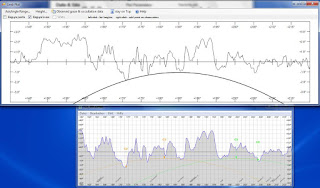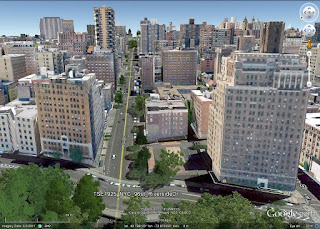 |
| Fig.00 TSE 1925 Jan24 in NYC, eclipse paths by Jubier and Herald |
There has been a lively discussion on the Yahoo Solar Eclipse mailing list SEML about the Total Solar Eclipse of Jan. 24, 1925 and the southern limit of the totality zone - observations versus computations using modern software and Google Earth/Maps.
The eclipse happened in New York City in the morning with the sun at 17 deg. elevation.
The southern edge of the totality zone was reported from a dense line of observations to be at 96th St. at the intersection with Riverside Dr. (SEML Msg #16462 #16471) and Edison-Report (PDF)
 |
| Fig. 01 pg. 10 from Edison-Report |
tomhaeberle #16462 jan.24
As many of you know the 1925 eclipse was well-documented. Astronomers wanted to
use the Manhattan Gridline to help Map the southern limit of the eclipse. It was
determined with the help of a 149 workers of the NY Edison company that the line
crossed between 95th and 97 street centering on 96 street (from the actual NY
Times article).
mzeiler #16471 jan.25
The famous measurement of the observed limit line is described
here http://adsabs.harvard.edu/full/1925ApJ....61..207F and states that the
limit line was observed to be about the intersection of Riverside Drive and 96th
street. This is about a 1 km perpendicular offset from the modern computed
southern limit line.
The discussion dealt with the plotted path of the southern edge in Google Maps/Google Earth
using data from the 5-millenium atlas by Jubier resp. Espenak. It is displayed 800m south of 96 St.
The line given by Dave Herald's Occult 4.1.0 is even 300m further south (Ephemeris DE414/LE414 with DE423/LE423).
Actually Espenak states: The accuracy of the northern and southern edges of the eclipse path are limited to approximately 1-2 kilometers due to the lunar limb profile.
Circumventing potential projection problems, we can calculate local circumstances. Xavier Jubier's tool V1.0.6 for the intersection 96th St/Riverside Dr. yields 15 sec totality after limb corrections.
Three Saros cycles later an almost identical repetition occurred in Oregon. The southern shadow edge was again determined observationally (OSU Solar eclipse expedition , gallery).
Incidentally at my site north of Madras OR totally lasted about 19 sec, almost identical to the prediction for NYC 96th St.
However for the 1979 event theory and observation match very closely. (Blog)
Further checks were made using Beads Analysis in Herald's Occult 4.1.0.
For the NYC site at 96th St., Occult predicts totality of 14 sec between 14:10:43 and 14:10:57 UTC
in close agreemant with Xubier's local circumstances.
So it appears that, aside from the problem connected with projections of the totality zone edges
in 1925 there seems to be a real discrepancy between the reported southern limit from observations and the local circumstances computed for that location using modern eclipse software.
The profile is very sensitive to the solar radius parameter. A value of 0.5" of the white-light emission zone between photosphere and chromosphere has been reported by Sigismondi et. al.
See Jay Pasachof, SEML #16492
Many subscribers to SEML will be interested in "Towards a Unified Definition of
Solar Limb during Central Eclipses and Daily Transits" by Costantino Sigismondi,
Andrea Raponi, Cyril Bazin, and Richard Nugent, http://arxiv.org/abs/1106.2197
and some other papers by Sigismondi at http://arxiv.org, searching on his name.
Update 2013 Feb 03
Simulation with Occult
Parameters:
Correction to solar radius = 0.4" to 0.5" (Fig. 09 to Fig.11)
Altitude = 50m (estimated rooftop height, Fig. 12)
This reproduces the observed edge of the totality zone at 96th St./Riverside Dr. in NYC
and essentially confirms John Irwin's findings in SEML #16512 Thu Jan 31, 2013 12:59 pm
"If we increase the solar radius by 0.05% to allow for this transition
region, and also include a ~50m elevation for the observers, then for the
location at the junction of Riverside Drive and W96th St. (73.97537W,
40.79635N) the true limb-corrected duration reduces from 14.9s to near zero!
In this particular situation, I find the observation point actually lies
outside the umbral outline but the closest-approach distance is only about
10m. I suppose one could vary the solar radius and/or elevation to pin-point
an exact grazing event, but I think we'd then be playing in the noise.
Greatest eclipse (if we can call it that) occurs at about 14:10:50 UT, with
a delta-T of 23.8s (which is close to the actual value of 23.6s).
Therefore with these considerations we can predict a near zero-duration
total eclipse consistent with the observations. I'm not sure the use of a
blackened film can be used to explain the discrepancy as I think that would
increase the duration, not decrease it as required to fit the observations.
John."
Circumstances:
The solar radius was 16', thus 0.05% corresponds to 0.48"
Solar distance r=0.984480 a.u.
Figures
 |
| 02 |
 |
| 03 |
 |
| 04 |
 |
| 05 |
 |
| 06 comparison Jubier/Maestro w/ Occult/Herald UTC 14:10:41 |
 | |
| 07 comparison Jubier/Maestro w/ Occult/Herald UTC 14:10:43 |
 |
| 08 comparison Jubier/Maestro w/ Occult/Herald UTC 14:10:57 |
 |
| Fig.09 solar radius + 0.40" |
 |
| Fig.10 solar radius + 0.45" |
 |
| Fig.11 solar radius + 0.50" |
 |
| Fig.12 Google Earth |

